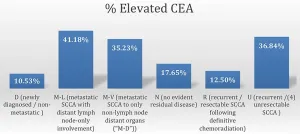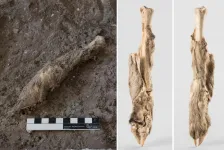(Press-News.org) For the first time, scientists have seen stony coral cells engulf dinoflagellates - single-celled, photosynthetic algae that are crucial for keeping coral alive
The researchers used a cell line called IVB5, which contains endoderm-like cells cultured from the stony coral, Acropora tenuis
Around 40% of coral cells incorporated the algae in around 30 minutes and remained healthy for one month
The research is a step towards understanding the partnership between coral and dinoflagellates and could shed light on how coral bleaching occurs
In a world-first, scientists in Japan have observed individual stony coral cells engulfing single-celled, photosynthetic algae.
The microscopic algae, known as dinoflagellates, were engulfed by cells cultured from the stony coral, Acropora tenuis, the scientists reported in the journal Frontiers in Marine Science.
"Dinoflagellates are crucial for keeping coral healthy and alive," said Professor Noriyuki Satoh, senior author of the study and head of the Marine Genomics Unit at the Okinawa Institute of Science and Technology Graduate University. "Coral cells take up the algae and provide them with shelter and the building blocks for photosynthesis. In return, the algae provide the corals with nutrients that they synthesize."
However, in recent decades, this essential relationship has been placed under strain. Driven by pollution, acidification and rising ocean temperatures, stressed coral cells are expelling the microscopic and colorful algae in mass bleaching events, resulting in huge swathes of dead, white reefs.
Stony coral from the Acroporidae family - the most common type of coral found within tropical and subtropical reefs - are particularly susceptible to these bleaching events. These fast-growing corals lay down calcium carbonate skeletons and therefore play a key role in building coral reefs.
"For coral reef conservation, it's vital for us to fully understand the partnership between stony coral and the algae that live inside these animals, at the level of a single cell," explained co-first Professor Kaz Kawamura from Kochi University. "But until recently, this was very hard to achieve."
Coral cells are notoriously difficult to culture, so previously scientists had to rely on experimental systems of other closely related marine creatures, like sea anemones, to study the mechanism of how the dinoflagellates enter and leave cells.
It wasn't until April 2021 that the research team made a major leap forward, reporting in Marine Biotechnology that they had successfully cultured different cell lines from larvae of the stony coral, Acropora tenuis, in petri dishes.
For this study, the scientists focused on one coral cell line called IVB5. Many of the cells in this line have similar properties to endodermal cells, in terms of their form, behavior and gene activity. Importantly, in whole coral organisms, it is the endodermal cells that engulf the algae.
The scientists added the dinoflagellate, Breviolum minutum, to a petri dish containing the IVB5 coral cells.
Around 40% of the coral cells in the culture quickly formed long, finger-like projections that reached out to contact the dinoflagellates. The algae were then "swallowed" up, in a process taking around 30 minutes.
"It was amazing to see - it was almost a dream!" said Prof. Satoh.
Over the following couple of days, the algae inside the cell were either broken down into fragments or were successfully enclosed into membrane-bound sacs, called vacuoles, within the cells. For the researchers, this hints at how the relationship possibly started millennia ago.
"It may be that originally, the ancestors of coral engulfed these algae and broke them down for food. But then over time, they evolved to use the algae for photosynthesis instead," co-first author, Dr. Satoko Sekida from Kochi University suggested.
The researchers are now using electron microscopes to gain more detailed images of how the coral cells engulf the dinoflagellates. They are also working on genetic experiments to pinpoint which coral genes are involved.
At this stage, the coral cells containing the algae live for around a month before dying. In the near future, the team hope to achieve a stable culture where both the coral cells and dinoflagellates can reproduce together.
"This would be very exciting as then we can ask new questions, like how the corals react when placed under stress," said Prof. Satoh. "This could give us a more complete understanding of how bleaching occurs, and how we can mitigate it."
INFORMATION:
A new paper in the Journal of the National Cancer Institute, published by Oxford University Press, indicates that disruptions in health care due to the COVID 19 pandemic may increase breast cancer deaths.
In March 2020 public health measures prohibited most elective procedures, including mammography, due to hospital capacity and limited personal protective equipment. This reduced mammograms up to 80%. Breast cancer patients also experienced treatment delays and reductions in planned or expected chemotherapy treatments.
Researchers here used three independently-developed breast cancer simulation models from the National Cancer Institute's Cancer Intervention and Surveillance Modeling Network to ...
Washington/Philadelphia, July 14, 2021--New research finds that high school students who attended school remotely during the COVID-19 pandemic suffered socially, emotionally, and academically compared with those who attended in person.
The study was published today in Educational Researcher (ER) by researchers Angela L. Duckworth, Tim Kautz, Amy Defnet, Emma Satlof-Bedrick, Sean Talamas, Benjamin Lira, and Laurence Steinberg. ER is a peer-reviewed journal of the American Educational Research Association.
"Many news stories have reported on individual stories of teenagers who have suffered from anxiety, depression, and other mental health challenges during the pandemic," said lead author Duckworth, ...
Oncotarget published "CEA as a blood-based biomarker in anal cancer" which reported that the mean Carcinoembryonic Antigen (CEA) among subgroups by clinical status at the time of presentation to our institution was highest among those patients with metastatic Squamous cell carcinoma of the anal canal (SCCA) to visceral organs, however this finding was not statistically significant by ANOVA .
By clinical subgroup, the percentage of patients with an abnormally elevated CEA was highest in those patients with metastatic disease to lymph nodes followed by recurrent/unresectable SCCA , and metastatic SCCA ...
New research published online in the International Journal of Mental Health and Addiction found that Canadians with a history of drug dependence are much less likely to have flourishing mental health and are more likely to have mental illness.
Researchers compared a nationally representative sample of 460 Canadians with a history of illicit drug dependence (excluding cannabis) to 20,305 Canadians with no history of illicit drug dependence using data drawn from Statistic Canada's Canadian Community Health Survey-Mental Health.
While 80% of those with a history of drug dependence were in remission, more than half (52.1%) were still experiencing mental illness. Further, only 37.9% were in excellent mental health, which is markedly lower than the 74.1% of ...
Unlike other population-level stressful events such as natural disasters, COVID-19 has not resulted in a net increase in smoking, according to a new study from the International Tobacco Control (ITC) Project, at the University of Waterloo.
The researchers also found that although nearly half of smokers reported that COVID-19 made them think about quitting, the vast majority of smokers did not change their smoking habits during the early phase of the COVID-19 pandemic.
Led by Shannon Gravely, research assistant professor with the ITC Project, the study ...
Before Millennials were over laugh-cry emojis, they were the most used emojis across the world, according to researchers at USC. The emoji was more popular than smiley faces say researchers who categorized millions of tweets across 30 countries and evaluated over 1700 emojis. Their study, "An empirical study of emoji usage on Twitter in linguistic and national contexts" was published in Online Social Networks and Media.
Mayank Kejriwal, a research assistant professor in the Department of Industrial and Systems Engineering, and a research lead at the USC Information Sciences Institute who is the lead author on the paper, says approximately 100 emojis are used most often.
The most important take away? Emojis represent ...
A new study by researchers at Queen Mary University of London, University of Oxford, Institute for Advanced Studies, Vienna, and the Medical University of Graz, has found that lateral flow tests detect Covid-19 with similar accuracy to laboratory-based PCR tests, providing they are used at the onset of infection and soon after symptoms start.
Lateral flow tests are cheaper and produce a result in just 30 minutes - much faster than the time it takes to receive a PCR test result, which can take 1-3 days. The finding could be pivotal to national strategies ...
A team of geneticists and archaeologists from Ireland, France, Iran, Germany, and Austria has sequenced the DNA from a 1,600-year-old sheep mummy from an ancient Iranian salt mine, Chehrābād. This remarkable specimen has revealed sheep husbandry practices of the ancient Near East, as well as underlining how natural mummification can affect DNA degradation.
The incredible findings have just been published in the international, peer-reviewed journal Biology Letters.
The salt mine of Chehrābād is known to preserve biological material. Indeed, it is in this mine that human remains of the famed "Salt Men" were recovered, dessicated by the salt-rich environment. The ...
Survival for a baby born with a birth defect - otherwise known as a congenital anomaly - is a "post-code lottery", according to scientists from 74 countries.
A study published today in The Lancet, led by researchers from King's College London, examined the risk of mortality for nearly 4000 babies born with birth defects in 264 hospitals around the world. The study found babies born with birth defects involving the intestinal tract have a two in five chance of dying in a low-income country compared to one in five in a middle-income country and one in twenty in a high-income country.
Gastroschisis, a birth defect where the baby is born with ...
A global study provides up-to-date estimates for the effect of alcohol consumption on cancers worldwide. It suggests that 4% of all newly diagnosed cancers in 2020 may be associated with drinking alcohol, with men accounting for more than three quarters of those cases.
Risky and heavy drinking was estimated to contribute the highest number of cancer cases, but moderate drinking - the equivalent of around two daily drinks - was estimated to lead to more than 103,000 cases in 2020, almost 1 in 7 of all alcohol-associated cases.
The proportion of new cancer cases associated with alcohol varied widely between world regions, with the lowest found in Northern Africa and Western Asia, and the highest in ...

